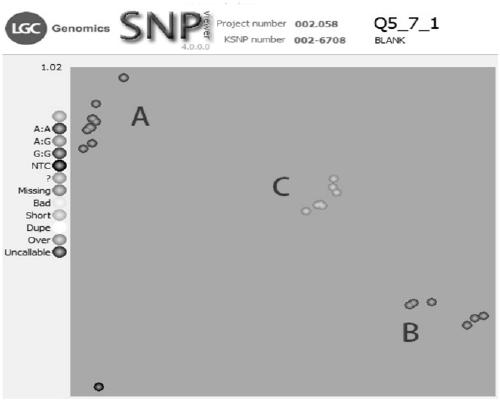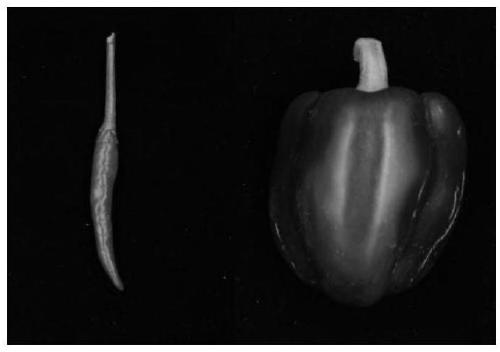Molecular marker linked to green retardation gene of pepper and application thereof
A technology of molecular markers and green-sustaining genes, which is applied in the fields of capsicum breeding and molecular biology, can solve the problems of unsatisfactory green-keeping effects and high costs, and achieve the goal of reducing planting scale, reducing workload, and improving efficiency and accuracy. Effect
- Summary
- Abstract
- Description
- Claims
- Application Information
AI Technical Summary
Problems solved by technology
Method used
Image
Examples
Embodiment 1
[0044] Example 1 Acquisition of the Molecular Marker SGR Molecular Marker Linked to the Capsicum Chlorophyllin Gene
[0045] BSR positioning method
[0046] 1. Group construction
[0047] The material 'CT2' (such as figure 2 shown on the left), and the material 'CS17' whose fruit color is brown is the parent (such as figure 2 Shown on the right side of the middle), all are resequenced pepper germplasm resources, the brown parent and the red parent were crossed to obtain the F1 generation, and the F1 generation was self-crossed to obtain the F2 population.
[0048] 2. Fruit color identification
[0049] After the fruit is ripe, the brown / red color of the fruit is identified.
[0050] 3. Fruit color main effect QTL analysis
[0051] F in CT2 x CS17 2 In the group, 30 plants with red fruit color and 30 mature fruits with brown fruit color were selected, and the fruits of each plant were mixed in equal amounts to construct a red fruit / brown fruit RNA mixed pool. The total...
Embodiment 2
[0056] Example 2 Verification of mature capsicum fruit color marking SGR
[0057] Using the molecular marker primers obtained for the color of the fruit, F 2 90 individual plants of the population carry out fruit color identification, and its steps are as follows:
[0058] (1) Carry out touchdown PCR reaction with pepper genomic DNA as a template; add 3 primers labeled with SGR to the reaction system, the sequence of the universal reverse primer labeled with SGR is SGR-1 (SEQ ID NO.1), and the two primers labeled with SGR A forward primer sequence is SGR-2 (SEQ ID NO.5) connected with a fluorescent linker sequence, and SGR-3 (SEQ ID NO.6) connected with a fluorescent linker sequence. Touchdown PCR reaction system: the total volume is 3 μl, and the specific components are as follows: ddH 2 O 1.4983μl, 2×KASPMasterMix 1.4792μl, two forward primers SGR-2 (SEQ ID NO.5) and SGR-3 (SEQ ID NO.6) connected with the fluorescent adapter sequence each 0.005μl (100uM), reverse To prime...
PUM
 Login to View More
Login to View More Abstract
Description
Claims
Application Information
 Login to View More
Login to View More - R&D
- Intellectual Property
- Life Sciences
- Materials
- Tech Scout
- Unparalleled Data Quality
- Higher Quality Content
- 60% Fewer Hallucinations
Browse by: Latest US Patents, China's latest patents, Technical Efficacy Thesaurus, Application Domain, Technology Topic, Popular Technical Reports.
© 2025 PatSnap. All rights reserved.Legal|Privacy policy|Modern Slavery Act Transparency Statement|Sitemap|About US| Contact US: help@patsnap.com



